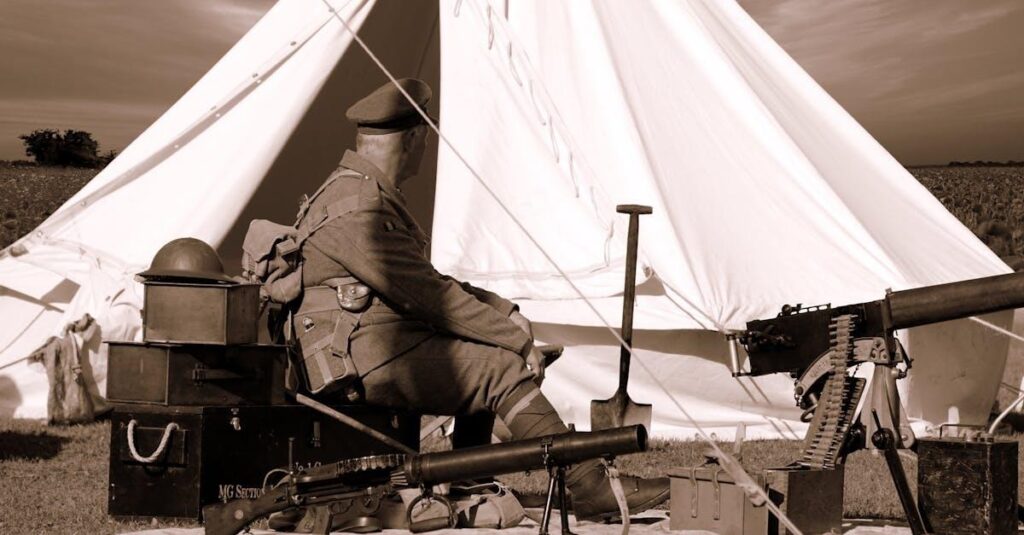Early Adoption of Asbestos in Military Equipment
Military forces rapidly adopted asbestos during the early 20th century for its fire-resistant properties. Its use proliferated, especially during significant conflicts.
World War I and II Era
During World War I, asbestos found applications in various military gear and vehicles due to its ability to withstand high temperatures. Ships used asbestos for insulation, gaskets, and engine room linings. Aircraft incorporated asbestos in brake linings and insulation. Soldiers’ uniforms sometimes included asbestos to provide extra protection against heat and fire.
World War II saw an even broader adoption. Naval ships contained extensive amounts of asbestos in boilers, turbines, and steam pipes. Tanks and military trucks used asbestos for brake pads, clutches, and gaskets. Barracks featured asbestos insulation to enhance fire safety. The pervasive use across different equipment underscored the material’s perceived indispensable value.
Post-War Applications
In the post-war era, asbestos continued to be integral in military applications. The construction of military bases and housing frequently employed asbestos for insulation and flooring. Aviation used asbestos in parts such as composites for jet engines, brakes, and electrical insulation. Military vehicles retained asbestos components in their braking and gasket systems.
Defense contractors produced various equipment with asbestos, leading to significant exposure risks for maintenance personnel. Veterans from this period still deal with health issues stemming from asbestos exposure during their service years.
The widespread usage reveals the significant reliance on asbestos despite the emerging health risks, leading to critical health consequences for those exposed.
Asbestos Uses in Various Branches of the Military
The military’s high demand for durable, heat-resistant materials led to widespread asbestos use during the 20th century. Different branches employed asbestos in specific equipment and infrastructure, increasing exposure risks for personnel.
Navy Equipment and Ships
Navy vessels frequently used asbestos for insulation, gaskets, and fireproofing. Boilers, turbines, and pipes were commonly lined with asbestos to prevent heat damage. Moreover, sailors often faced asbestos exposure while repairing or maintaining these ships, leading to heightened health risks.
Army Vehicles and Gear
Army tanks and trucks incorporated asbestos in brake pads, clutches, and gaskets. Asbestos was also utilized in personal gear, such as gas mask filters, to provide heat resistance. Maintenance crews working on these vehicles encountered significant asbestos exposure.
Air Force Aircraft and Facilities
Air Force aircraft used asbestos in engine components, insulation, and electrical wiring. Airbase facilities also featured asbestos in roofing, flooring, and fireproofing materials. Routine maintenance and facility upgrades posed exposure risks to service personnel.
Health Impact on Military Personnel
Asbestos exposure has led to severe health consequences for military personnel. Long-term exposure resulted in several debilitating diseases affecting veterans.
Types of Asbestos-Related Diseases
Military personnel faced numerous asbestos-related diseases. Mesothelioma, a rare cancer, forms in the lining of the lungs, abdomen, or heart. It develops after inhaling asbestos fibers, with symptoms manifesting decades later. Asbestosis, a chronic lung disease, causes scarring of lung tissue, leading to breathing difficulties and reduced lung function. Lung cancer, while more common, has an increased incidence among those exposed to asbestos. Other ailments include pleural plaques (calcified build-ups), pleural effusions (fluid buildup around the lungs), and chronic obstructive pulmonary disease (COPD).
Case Studies and Statistics
Studies show significant rates of asbestos-related illnesses among military veterans. The Department of Veterans Affairs (VA) reports that veterans constitute over 30% of all mesothelioma cases in the U.S. Data indicates naval shipyard workers among the most affected, with substantial exposure during World War II and the Korean War. Analyzing VA health records, a study found increased lung cancer incidence among veterans exposed to asbestos compared to non-exposed groups. Air Force mechanics, who handled aircraft brakes and clutches, recorded higher asbestosis cases. According to a published report from the National Institute for Occupational Safety and Health (NIOSH), exposure levels among Army vehicle maintenance workers were often above the safety threshold, leading to chronic pulmonary issues later in life.
| Disease | Typical Latency Period | Common Among |
| Mesothelioma | 20-50 years | Navy shipyard workers, construction personnel |
| Asbestosis | 10-30 years | Vehicle mechanics, construction workers |
| Lung Cancer | 15-40 years | General military personnel |
| Pleural Plaques | 10-30 years | Navy, shipyard workers |
| Chronic Pulmonary Issues | 10-40 years | Vehicle mechanics, aircraft technicians |
Veterans diagnosed with these conditions face significant health challenges, often requiring specialized medical care for managing symptoms and improving quality of life.
Government and Military Response
Early Warnings and Initial Actions
The government and military faced early warnings about the dangers of asbestos as early as the 1930s. Reports from medical professionals began to indicate that prolonged exposure led to serious health issues. Despite these warnings, the military continued to use asbestos extensively during World War II, prioritizing its fire-resistant properties over potential health risks. It wasn’t until the 1970s, with increasing evidence linking asbestos to serious illnesses, that significant actions were taken. The Navy started reducing asbestos use in new ships, and other branches began assessing the extent of asbestos in their equipment. However, much of the existing asbestos remained in use, continuing to pose risks to maintenance and repair personnel.
Legislative Measures and Compensation Programs
In response to growing health concerns, the U.S. government enacted several legislative measures. The Clean Air Act of 1970 and the Toxic Substances Control Act of 1976 regulated asbestos use and set guidelines for exposure limits. Additionally, the Asbestos School Hazard Abatement Act of 1984 addressed asbestos issues in educational institutions, indirectly benefiting military family members. Compensation programs were also established to support affected veterans. The Department of Veterans Affairs (VA) recognizes asbestos-related diseases as service-connected disabilities, offering benefits and healthcare services to affected individuals. Special registries and screening programs were implemented to identify and treat veterans with asbestos-related health conditions.
Ongoing Challenges and Future Outlook
Military personnel and veterans continue to face challenges related to past asbestos exposure. Addressing these challenges involves ongoing efforts in removal, remediation, and dealing with emerging health concerns.
Removal and Remediation Efforts
The military has undertaken extensive asbestos removal projects to mitigate the health risks posed by this hazardous material. Decommissioned ships, aircraft, and buildings undergo controlled asbestos abatement to ensure the safety of maintenance crews. For example, the Navy systematically removes asbestos from older vessels as part of their regular maintenance schedules. Additionally, new construction and refurbishments involve strict adherence to regulations that ban asbestos use.
Emerging Health Concerns
Advances in medical research highlight ongoing health risks linked to asbestos exposure. Veterans continue to be diagnosed with asbestos-related diseases such as mesothelioma and lung cancer. Moreover, the long latency period of these illnesses means cases may emerge decades after initial exposure. Studies indicate that second-hand exposure, affecting families of military personnel, also poses significant health risks. Ongoing monitoring and research are crucial to identify and address these emerging health challenges.
Government agencies, including the Department of Veterans Affairs, expand health services and support for those affected, aiming to provide comprehensive medical care and compensation for asbestos-related conditions.
The historical use of asbestos in military equipment has had lasting health impacts on veterans and service personnel. Despite its fire-resistant properties making it a valuable material, the severe health risks associated with asbestos exposure were largely ignored until the late 20th century. Veterans continue to face challenges related to asbestos-related diseases, necessitating ongoing health monitoring and support.
The military’s efforts to mitigate these risks through extensive removal and remediation projects are crucial. Government agencies remain committed to providing comprehensive care and compensation for those affected. Continued research and vigilance are essential to address the long-term health consequences of asbestos exposure in the military.
Useful Websites
- Mesothelioma Vets
- Cleveland Clinic
- VA.gov
- Mesothelioma Guide
- NIH.gov
- The Mesothelioma Veterans Center
- Mesothelioma Hub
- Purple Heart Foundation

